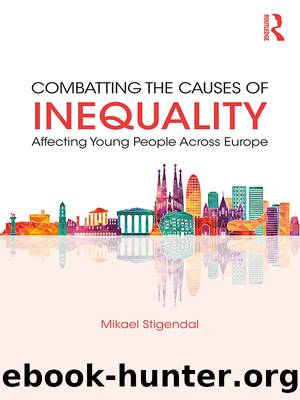Combatting the Causes of Inequality Affecting Young People Across Europe by Mikael Stigendal

Author:Mikael Stigendal [Stigendal, Mikael]
Language: eng
Format: epub
Tags: Social Science, General, Sociology
ISBN: 9781351848244
Google: ZRdWDwAAQBAJ
Barnesnoble:
Goodreads: 32452471
Publisher: Routledge
Published: 2018-04-19T00:00:00+00:00
The âRotterdam-Buzinezzclubâ claims to be âthe opposite of the acclaimed âhit and runâ mentality of many re-integration firmsâ, as the report puts it, âthere is ample evidence that this is true, in theory and practiceâ. The authors may be right, but when many companies turn into an accumulation of capital by dispossession, it seems important to scrutinise the selectivity of these social structures.
As the authors of the report write, the âRotterdam-Buzinezzclubâ in Rotterdam âaddresses the unemployment of young people with few chances in the labour market. It is a private, for profit, initiative aimed at developing entrepreneurship among young people on social assistance by broadening their network and their skills.â The young participants receive support in âdeveloping their ideas into realistic business plan, or towards new plans for picking up education again or for more successful ways of trying to enter the labour market.â A partnership has been formalised by the use of a Social Impact Bond (SIB). This is a financial construction in which private parties invest in solving a social problem that costs the local government a lot of money. The local government pays back with the money it is saving, including possible interest. The faster young people move out of the allowance system, the higher the interest. On the other hand, the âRotterdam-Buzinezzclubâ and investors run the financial risk; the municipality does not. To the extent that the re-integration of young people fails and they do not move out of the allowance system, the âRotterdam-Buzinezzclubâ and its investors have to pay the cost.
This construction puts a pressure on the âRotterdam-Buzinezzclubâ to succeed in accordance with the predetermined goals and also to do it as fast as possible. That raises several urgent questions. What space does this enable for the young people to be critical? How can they be fostered to become critical citizens? Will such a fostering not contradict the demands for a profit as it takes too much time? Obviously, the âRotterdam-Buzinezzclubâ does not address the causes of inequality, but does it not actually entail an interest in preserving the causes? The whole business idea relies on the existence of causes that generate a constant flow of affected young people. All these participants are unemployed and without basic qualifications. They are all selected by the municipal Youth Coaches. That makes the âRotterdam-Buzinezzclubâ dependent on the municipality and its employees at the Youth Counter. According to the Director of the Buzinezzclub, this is a key problem and he describes the municipality as monopolist. âAt the same timeâ, the authors of the report remind us, âthe fact that the Buzinezzclub is one of the few organisations allowed to deal with the âmonopolistâ gives it a clear advantage.â
But what happens if the âRotterdam-Buzinezzclubâ loses its own monopoly and the municipality opens up for competition? That would probably increase the pressure on the companies to succeed with the predetermined goals even faster, probably then also to the detriment of fostering young people to become critical citizens. There may then also arise a competition for investors.
Download
This site does not store any files on its server. We only index and link to content provided by other sites. Please contact the content providers to delete copyright contents if any and email us, we'll remove relevant links or contents immediately.
Doing It: Let's Talk About Sex... by Hannah Witton(9240)
Thirteen Reasons Why by Jay Asher(8848)
The Girl Without a Voice by Casey Watson(7849)
The Incest Diary by Anonymous(7636)
Should I Stay or Should I Go? by Ramani Durvasula(7624)
The Lost Art of Listening by Michael P. Nichols(7456)
The Leavers by Lisa Ko(6930)
The Space Between by Michelle L. Teichman(6899)
The Testaments by Margaret Atwood(6839)
The Four Agreements by Don Miguel Ruiz(6704)
Rich Dad Poor Dad by Robert T. Kiyosaki(6517)
The Rosie Project by Graeme Simsion(6300)
Beartown by Fredrik Backman(5682)
We Need to Talk by Celeste Headlee(5575)
Ego Is the Enemy by Ryan Holiday(5350)
Men In Love by Nancy Friday(5197)
Spare by Prince Harry The Duke of Sussex(5142)
Hunger by Roxane Gay(4894)
Suicide Notes by Michael Thomas Ford(4790)
